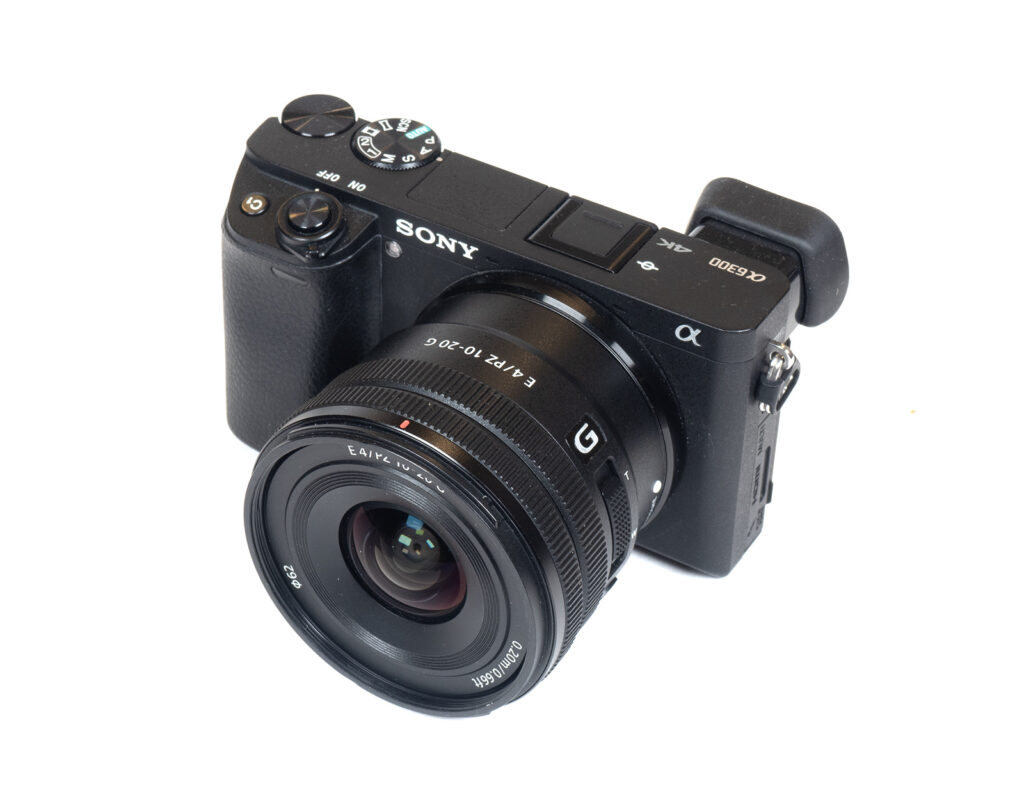Introduction
One of the differentiators of Sony’s E-mount is the triple-grade lens lineup. Besides the budget and professional GM lenses, there’s an extensive set of G-class lenses. These lenses aren’t quite as well-corrected or as fast as their GM counterparts, but they are very appealing in terms of pricing. For Sony enthusiasts without very deep pockets, this is clearly the place to be. Most of these G lenses are full format, but there are a few available specifically optimized for APS-C cameras. One of them is the Sony E 10-20mm f/4 PZ G, which sells for around $750 USD.
Upon first contact, you will be surprised by its size – it’s tiny and also featherlight. Yet the build quality is still perfectly fine, including a dust- and moisture-resistant design as well as internal zooming. Speaking of zooming – this a a “PZ”= Power Zoom lens. The zoom ring, as well as a zoom lever, are driving a motor. While photographers may shrug at this, videographers may be thrilled. It’s even possible to operate the zoom remotely via the optional GP-VPT2BT Wireless Shooting Grip or from a linked smartphone. The focus ring operates smoothly, of course.
A petal-shaped lens hood is usually part of the package (except with our rental lens, so we can’t show it below).

Sony has incorporated no less than two linear AF motors, so autofocusing is both fast and silent. Manual focusing works “by wire”, as usual. Focus breathing has been minimized for video shooting – and breathing compensation is available with most modern Sony cameras. Unlike on the old E 10-18mm f/4 OSS, an image stabilizer has not been implemented.
| Specifications | |
|---|---|
| Optical construction | 11 elements in 8 groups (2x ED, 3x aspherical, 1x hybrid) |
| Number of aperture blades | 7 (rounded) |
| min. focus distance | 0.13m (max. magnification 1:5.6) |
| Dimensions | 69.8 x 55mm |
| Weight | 178g |
| Filter size | 62mm |
| Hood | Petal shape, bayonet type, supplied |
| Other features | Dust- and moisture-resistant, power zoom, focus hold button, remote zoom via accessory |
Distortion
In the introduction, we mentioned that G-class lenses aren’t quite as well corrected as their GM counterparts. This usually shows up in the image distortion chapter – and it’s also the case here. As you can see below, RAW images show a rather massive barrel distortion of 6.5% at 10mm. This eases the more you stop down, and images are distortion-free around the 16mm mark – before switching to pincushion distortion, which reaches its peak at 20mm at a moderate 1.4%.
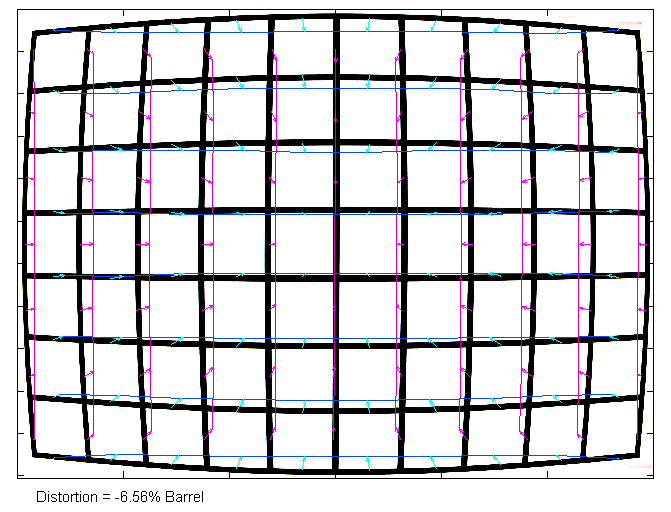

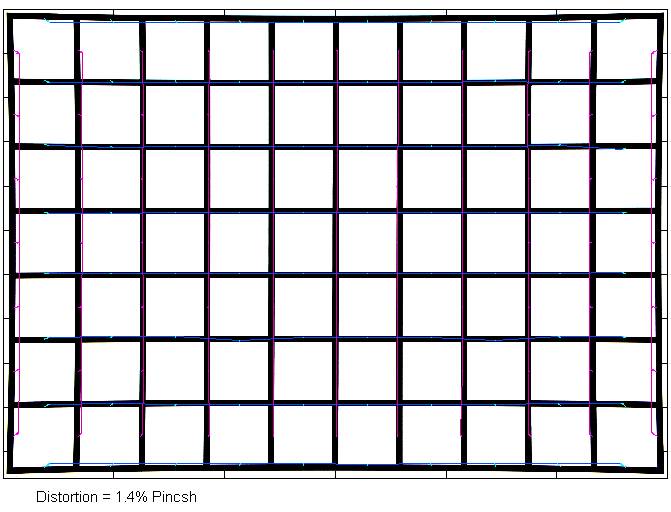
With activated auto-correction, the distortion at 10mm is drastically reduced to just 0.7%, and the issue is negligible beyond.


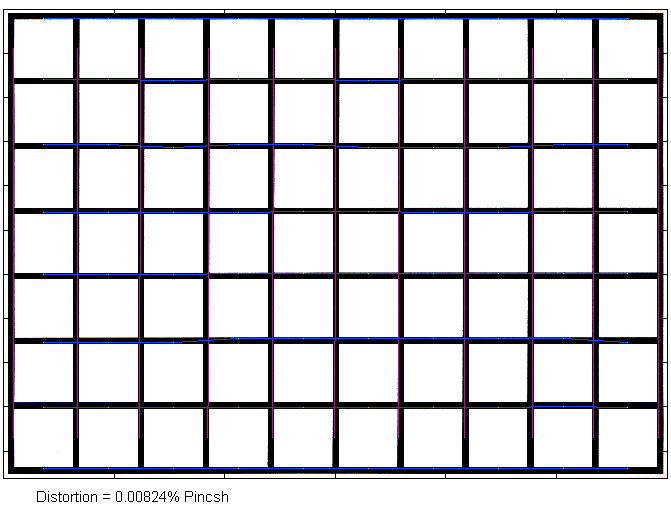
Vignetting
The other aspect where the effects of the tiny size show up is vignetting. At 10mm, we can see RAW vignetting figures that are usually only associated with full-format lenses – at 3 EV (f-stops). Stopping down reduces the issue, but even at f/11, the figure is beyond our usual scale for APS-C lenses. The vignetting isn’t quite as heavy at 14mm and 20mm, but it’s still far from being “good”.

Activated image auto-correction is drastically reducing the vignetting down to negligible levels. However, keep in mind that this comes at the cost of signal boosting or in other words – increase corner noise.
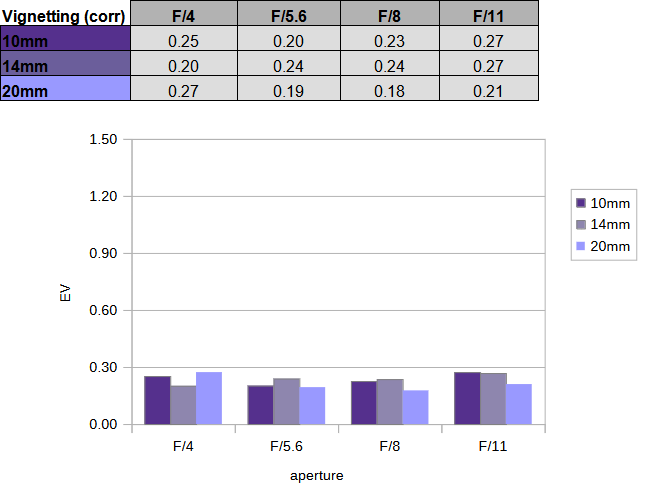
MTF (resolution)
The E 10-20mm f/4 PZ G produced decent results in the lab (but see below (*)). The center performance is generally excellent at 10mm, and the near center is very good. The border quality is good to very good, whereas the corners fall a bit behind while still being very decent for such an extreme focal length. The 14mm setting is a tad better in the outer image field. There’s a drop in quality at 20mm. The center isn’t as tack-sharp anymore but the borders and corners remain on a high quality level.
(*) The centering quality of the tested sample was rather bad, with a softness on the right image side. Consequently, the border/corner data was obtained on the left image side. A perfect sample may have performed a bit better still. Given the centering issue, it’s hard to produce a statement about field curvature, but if pressed, we’d say that it is on a medium level.
Please note that the MTF results are not directly comparable across the different systems!
Below is a simplified summary of the formal findings. The chart shows line widths per picture height (LW/PH) which can be taken as a measure of sharpness. If you want to know more about the MTF50 figures, you may check out the corresponding Imatest Explanations.

Chromatic Aberrations (CAs)
Lateral CAs are very well controlled. They stay well below the 1px mark at the image borders across the range. There is some increase in the extreme corners, though. Regardlessly, auto-correction or your favorite RAW converter should be able to handle this.

Sun-Stars
Wide-angle lenses are often used for nighttime images – and sun stars can be a nice effect around pointy, bright light sources.
Just like most lenses, the Sony E 10-20mm f/4 G has a circular aperture at maximum aperture – resulting in a light “blob” rather than sun stars, and there isn’t much going on at f/5.6 either. Some rays start to appear at f/8, but for more obvious rays, you should stop down to f11. The rays are somewhat fan-style rather than the ideal pointy style.

Competition
The Sony E 10-20mm f/4 PZ G (shown to the left below) has 2 main competitors – the Sigma 10-18mm f/2.8 DC DN Contemporary (center) and the Tamron 11-20mm f/2.8 Di III-A RXD (to the right). Both are strong contenders, and they give you an extra stop for the same money. The Sigma lens is especially attractive because it’s barely any bigger. Conversely, none of the third-party lenses is as suitable for video as the Sony lens – if that’s your thing.

Sample Images
Note: Because of the reported centering issue, most of our sample images below are in vertical mode – hiding most of the softer parts. It would be rather pointless to emphasize the defect.
Sony states that the Sony E 10-20mm f/4 PZ G is the "smallest, lightest f/4 ultra-wide APS-C power zoom" - which is a rather silly marketing statement because there aren't any other lenses with these specs around anyway . However, it is a tiny lens indeed, and with a weight of just 178g, you barely notice it in your bag. So is it any good (if you get a well-centered sample unlike us)? Mostly, it is. In terms of resolution, it doesn't really have a weak spot. It's generally very sharp in the image center and the outer image field is pretty decent. It doesn't really stand out either, though. Sony had to accept some compromises to make the lens this small. The native distortion and vignetting figures are very high and it relies on heavy auto-correction here. However, that's not unheard of from other lenses as well.
Feature-wise, the E 10-20mm f/4 PZ G has been optimized for video. This is most obvious with the power-zoom mechanism which is used both via the zoom ring as well as a zoom lever. Even remote zooming is possible. Focus breathing has also been reduced, especially with cameras that also offer breathing compensation. The build quality of the lens is pretty good despite the low weight.
If you are into video, the Sony lens is an obvious choice whereas it's less clear for photos. While many users prefer zoom lenses, we'd rather recommend a prime lens - namely the Sony E 11mm f/1.8 prime lens.
-
Optical Quality
-
Build Quality
-
Price / Performance


